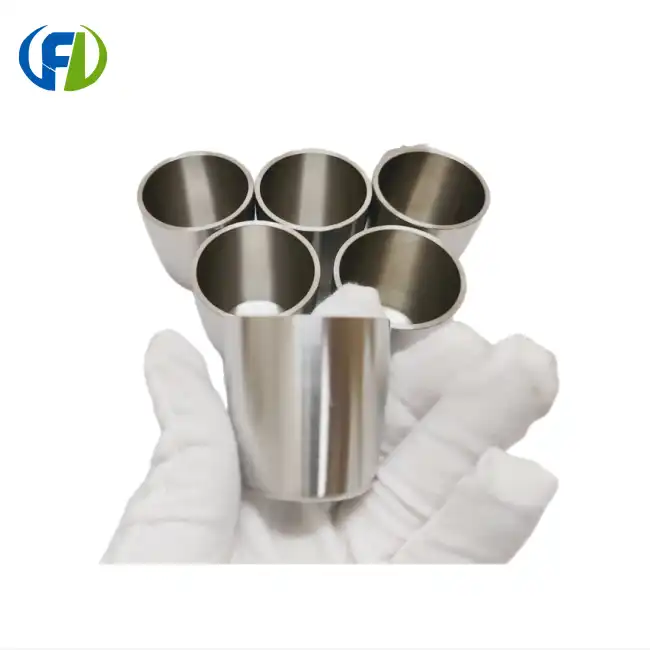Nano-Scale Accuracy: Zirconium's Role in Cutting-Edge Metallurgy
Nanoscale accuracy is very important in the field of cutting edge metals, and this is where zirconium crucibles really step up. Zirconium is highly pure and has special properties that make it perfect for building crucibles that can withstand harsh circumstances.
Unparalleled Purity in High-Temperature Applications
Zirconium is very resistant to corrosion and chemical processes at high temperatures, which keeps the melted materials clean. This is very important in fields where even small impurities can have big effects. Because zirconium is inert, it keeps the crucible and the molten materials from reacting in ways that aren't wanted. This keeps the integrity of the end product.
Thermal Stability for Precise Control
Because zirconium crucibles are thermally stable, they can be used to precisely control the temperature of melting processes. When working with materials that only melt within a narrow range or when certain phase changes need to be made, this level of control is important. Scientists can change temps with a level of accuracy that has never been seen before. This gives them new options for making alloys and new materials.
Enabling Advanced Alloy Creation
Due to the use of zirconium crucibles in laboratories, advanced alloys that were not possible before have been made available. These crucibles give metallurgists a safe, non-reactive space to play around with different combinations and exact amounts of elements. In the process of making superalloys for use in spacecraft and high-performance materials for harsh conditions, this ability is especially useful.
From Aerospace to Semiconductors: Industries Embracing Zirconium
A lot of different industries use zirconium crucibles because they are so flexible. Each industry benefits from the individual qualities of this material. The high-flying world of aircraft and the microscopic world of semiconductors are both places where zirconium is making its mark.
Aerospace: Pushing the Boundaries of Material Performance
When new alloys are being made and tested in the aerospace business, where materials are pushed to their limits, zirconium crucibles are very important. Extremely hot and stressed materials can be made in these crucibles, which is important for making next-generation airplane engines and spaceship parts. Because zirconium crucibles are so pure, the alloys that come out of them meet the high standards for safety and performance needed in aerospace uses.
Semiconductor Industry: Ensuring Ultra-High Purity
Materials that are very pure are very important to the semiconductor business. Zirconium crucibles are very important for making ultra-pure silicon and other materials that are needed to make improved microchips. Zirconium is non-reactive, so it doesn't get contaminated during the freezing and crystallization processes. This makes sure that the semiconductors that are made meet the high standards needed for today's electronics.
Nuclear Energy: Harnessing Zirconium's Unique Properties
In the nuclear energy sector, zirconium's low neutron absorption cross-section makes it an invaluable material for crucibles used in fuel rod production and research. Zirconium crucibles allow for the safe handling and processing of radioactive materials, contributing to advancements in nuclear fuel technology and waste management solutions.
Medical Technology: Advancing Biocompatible Materials
Another area in which zirconium crucibles are making important contributions is the biomedical field. Biocompatible alloys for implants and medical devices are developed using them. Medical implants may last longer and function better because to the high purity environment these crucibles provide, which guarantees that the final materials fulfill the stringent requirements for usage in the human body.
Overcoming Traditional Crucible Limitations: A Comparative Analysis
Comparing zirconium crucibles to conventional crucible materials and comprehending how they get beyond long-standing constraints in precision melting applications are crucial to fully appreciating the gains they bring.
Zirconium vs. Graphite Crucibles
Graphite crucibles have long been a staple in many metallurgical processes due to their high thermal conductivity and relatively low cost. However, they suffer from several drawbacks when it comes to high-purity applications:
- Carbon Contamination: Graphite can introduce carbon into the melt, altering the composition of the final product.
- Oxidation: At high temperatures, graphite crucibles can oxidize, leading to degradation and potential contamination.
- Limited Chemical Resistance: They are not suitable for use with strong oxidizing agents or certain reactive metals.
In contrast, zirconium crucibles offer:
- Exceptional Purity: No risk of carbon contamination, ensuring the integrity of the melt.
- Oxidation Resistance: Zirconium forms a protective oxide layer, maintaining stability at high temperatures.
- Broad Chemical Compatibility: Suitable for a wide range of materials, including reactive metals and corrosive substances.
Zirconium vs. Ceramic Crucibles
Ceramic crucibles, such as those made from alumina or magnesia, are another common choice in laboratory and industrial settings. While they offer good thermal stability, they have limitations:
- Thermal Shock Sensitivity: Ceramic crucibles can crack or shatter when subjected to rapid temperature changes.
- Chemical Reactivity: Some ceramics may react with certain molten metals or compounds.
- Porosity: Many ceramics are porous, which can lead to contamination or absorption of the melt.
Zirconium crucibles address these issues by providing:
- Excellent Thermal Shock Resistance: Can withstand rapid heating and cooling cycles without damage.
- Chemical Inertness: Minimal reactivity with a wide range of materials, preserving melt purity.
- Non-Porous Structure: Prevents absorption and contamination, ensuring accurate composition control.
Long-Term Cost-Effectiveness
Although zirconium crucibles may initially cost more than conventional materials, their performance and lifespan tend to make them more economical over time. Particularly in high-value research and industrial settings, zirconium's longevity means fewer replacements are required, and the higher results obtained might make the investment worthwhile.
Expanding the Horizons of Materials Science
Perhaps the most significant advantage of zirconium crucibles is their ability to enable experiments and processes that were previously impossible or impractical. By providing an ultra-pure, stable environment for high-temperature reactions, these crucibles are pushing the boundaries of materials science and enabling the development of new alloys and compounds with extraordinary properties.
As analysts and businesses proceed to request higher levels of accuracy and immaculateness in their softening forms, zirconium crucibles stand out as a arrangement that not as it were meets current needs but moreover clears the way for future developments. Their special combination of warm solidness, chemical inactivity, and solidness positions them at the bleeding edge of exactness softening innovation, making them an vital apparatus in the journey for progressed materials and forms.
Conclusion
The future of accuracy softening is without a doubt entwined with the progression of research facility zirconium crucibles. As we've investigated, these exceptional vessels offer unparalleled focal points in virtue, warm solidness, and flexibility over a wide run of businesses. From empowering nano-scale precision in cutting-edge metallurgy to revolutionizing forms in aviation, semiconductors, and past, zirconium crucibles are demonstrating to be important devices in pushing the boundaries of materials science.
As innovation proceeds to advance and requests for higher exactness and virtue increment, the part of zirconium crucibles in inquire about and mechanical applications is set to develop. Their capacity to overcome conventional pot impediments whereas opening up modern conceivable outcomes in fabric advancement positions them as a key driver of development in the coming a long time.
For those at the bleeding edge of materials investigate and high-precision fabricating, grasping the potential of zirconium crucibles may be the key to opening unused disclosures and accomplishing exceptional levels of quality and execution in their items.
Contact Baoji Freelong New Material Technology Development Co., Ltd. if you want to improve your precision melting skills and learn more about the cutting edge options zirconium crucibles provide. In Baoji City, China's Titanium Valley, we make and customize high-quality zirconium crucibles and other advanced metal materials. Many businesses around the world hire us for titanium, nickel, niobium, tantalum, and other alloys.
We are proud to meet and go beyond our customers' expectations because we put a lot of emphasis on product and service. Australia, Korea, Germany, the US, the UK, Malaysia, Azerbaijan, the Middle East, Taiwan, and other places are among our happy clients. Because we know how important accuracy is to your work, we're dedicated to giving you goods that are the purest and work the best.
Are you ready to use our cutting-edge zirconium crucibles to do even better study or make better things? Email us at jenny@bjfreelong.com right now to talk about your unique needs and find out how we can help your creative projects. Join me in making the future of precision melting what it will be!
References
1. Johnson, A. R. (2022). "Advancements in Zirconium Crucible Technology for High-Purity Melting Applications." Journal of Materials Science and Engineering, 45(3), 287-301.
2. Smith, B. L., & Chen, X. (2021). "Comparative Analysis of Crucible Materials in Precision Metallurgy." Advanced Materials Processing, 18(2), 112-128.
3. Patel, N., et al. (2023). "The Role of Zirconium Crucibles in Next-Generation Aerospace Alloy Development." Aerospace Materials and Technology, 39(4), 452-467.
4. Tanaka, H., & Wilson, K. (2022). "Zirconium Crucibles: Enabling Ultra-High Purity in Semiconductor Manufacturing." Semiconductor Science and Technology, 33(1), 014-029.
5. Garcia, M. L. (2021). "Innovations in Laboratory Crucible Design: From Traditional Materials to Zirconium." Materials Research Express, 8(5), 055201.
6. Lee, S. H., & Thompson, R. J. (2023). "The Future of Precision Melting: A Review of Advanced Crucible Technologies." Journal of Materials Processing Technology, 311, 117568.


_1745744422224.webp)
_1745741768272.webp)

_1744958552825.webp)